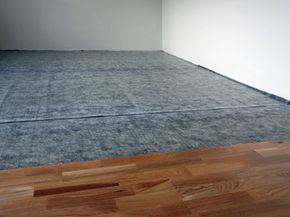Blocking Sounds in Floors and Ceilings
We've looked at how to block neighbor noises that are coming through your walls, but what if the noise is coming from above or below? Whether it's heavy footsteps or loud stereos, noise from those living on other floors can really be a pain. To help reduce these noises, we must look for ways to block sound waves, or at least slow them down as much as possible.
Let's start with the floor. If noise from downstairs neighbors is coming through your floors, your first step should be to add carpeting to help dull the sounds. There's no need to fully carpet the floor, as even a selection of scatter rugs will help. To further reduce sound transmission, add carpet padding to new or existing carpets. Go with the thickest padding you can find that is compatible with your carpet. If you plan to install new laminate, engineered, or wood floors at any point, be sure to choose a model with a built-in layer of insulation.
Advertisement
Carpeting and padding still not enough to keep the noise down? Try Green Glue. Green Glue is a viscoelastic compound that's used to block sound in walls, floors and ceilings. Green Glue is an incredibly effective sound blocker, eliminating about 90 percent of noise [source: Green Glue].
For noise that's coming from upstairs, install a drop ceiling in your home. Use resilient channel, and invest in acoustical tile that's designed to block noise. Because the drop ceiling is situated below the original drywall ceiling, the plenum space in between helps isolate noises from footsteps or similar sounds. The acoustical tile itself helps absorb and dissipate the remainder of the noise before it gets into your home.
If you don't like the look of drop ceilings or aren't willing to invest in one, you can simply double up the drywall on your existing ceiling. Use resilient channel to create a space between the two layers, as this is a great way to isolate sound waves. For further sound reduction, add a layer of Green Glue or an acoustical mat product between the drywall layers [source Manfredini].
If all of the above techniques are out of your budget, simply drape a nice fabric across the ceiling in a decorative manner. The fabric will help to absorb and dissipate a bit of the noise from above.
Read on to the next section to learn how to block sound coming through doors, windows, and ductwork.
